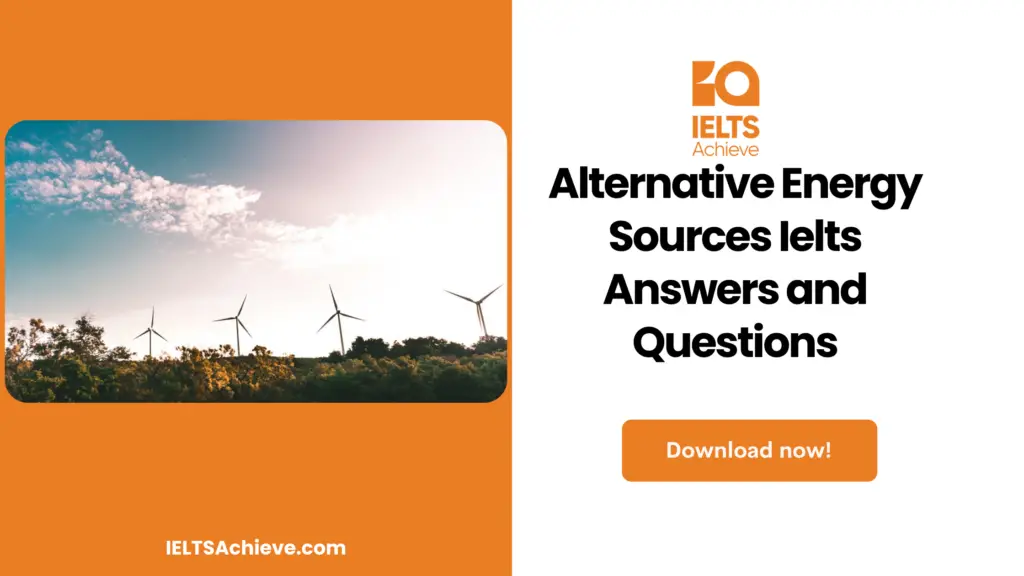The Blog post contains the following IELTS Reading Questions:
- IELTS Reading Multiple Choice Questions
- IELTS Reading True/False/Not given
- IELTS Reading Sentence Completion

IELTS reading passage – Alternative Energy Sources
Alternative Energy Sources
Alternative energy sources are being pursued for a variety of reasons. Many countries have signed the Kyoto Protocol, making measures to reduce pollutants and greenhouse gases a top priority in today’s culture. Alternative, or renewable, energy sources hold a lot of promise for reducing the quantity of pollutants produced as a result of energy use. Alternative energy not only protects against unwanted by-products, but it also helps to maintain many of the natural resources that we now utilise as energy sources. It’s crucial to know what sorts of alternative energy are available in order to comprehend how they can assist protect the planet’s delicate ecological balance and conserve non-renewable energy sources like fossil fuels.
Alternative energy sources are constantly replaced, non-polluting resources. They are not caused by fossil fuel combustion or atom splitting. Utilisation of renewable energy helps supplement our energy supply. Alternative energy sources include biomass energy, geothermal energy, hydroelectric power, solar power, wind power, fuel cells, ocean thermal energy conversion, tidal energy, and wave energy.
Biomass is a type of renewable energy derived from organic matter. Wood, forest and mill leftovers, animal waste, cereals, agricultural crops, and aquatic plants are all examples of biomass fuels. These materials are used as fuel to heat water for steam generation or are processed into liquids and gases that can be burned to achieve the same result. By 2020, the United States could generate up to four-and-a-half times more biopower thanks to increased biomass use, cheaper production costs, and improved technology. It is predicted that biomass would grow at the fastest rate among renewable energy sources, increasing by 80 percent to 65.7 billion KW by 2020.
Geothermal energy extracts heat from the earth’s interior. To deliver the hot water or steam to the surface, wells are bored into geothermal reservoirs. In geothermal facilities, the steam drives a turbine-generator, which generates energy. This heat is used to heat homes and greenhouses in some regions, as well as to supply processed heat for businesses and industries. Iceland’s capital, Reykjavik, is heated by geothermal energy. The majority of geothermal resources are found in the western United States. Geothermal heat pumps heat and cool homes by tapping into shallow earth energy, and they may be used practically anyplace. Much more power could be generated from hydrothermal resources with technical advancements. Scientists have been experimenting with geothermal power plants by pumping water into the hot, dry rock 3-6 miles beneath the earth’s surface.
Hydroelectric (hydropower) energy is produced by driving turbine-generators with the force of falling water. Hydroelectricity generates more electricity than any other renewable energy source. Estimates indicate that hydroelectric power in the United States will decrease from 389 billion KW in 1999 to 298 billion KW in 2020. The majority of the best hydropower sites have already been developed, and there are concerns about the environmental impact of large-scale hydroelectric installations, therefore this decline is anticipated.
Solar power is produced without the use of a turbine or an electromagnet. Photovoltaic cells on special panels catch sunlight and convert it directly into electricity. A battery is used to store the electricity. Solar energy can also be utilised to heat domestic water directly (solar thermal technology). The domestic photovoltaic (PV) industry might supply up to 15% of the new peak electricity capacity required in the United States by 2020.
Electricity can be generated using wind energy. The blades of a windmill spin when wind blows past them. The shaft connected to the blades rotates, powering a pump or turning a generator to generate electricity. After that, electricity is stored in batteries. The amount of energy that can be produced is determined by the wind speed and the size of the blades. In windier areas of the country, wind energy is more efficient. The majority of wind energy is generated by wind farms, which are enormous clusters of turbines positioned in reliably windy areas. Wind as a source of energy is both free and non-polluting, with no emissions or chemical waste. Wind-generated electricity is becoming more prevalent.
Fuel cells are electrochemical devices that use a chemical reaction to generate power. Fuel cells are rechargeable, have no moving parts, are quiet, and have no moving parts. Scientists are investigating how they could be utilised as a power source for almost-emission-free autos and as electricity-generating plants. The exorbitant cost of producing fuel cells has kept this important energy source from becoming widely used.
Ocean sources; Oceans, which span more than 70% of the earth’s surface, contain both thermal and mechanical energy from the sun’s heat and tides and waves. Solar radiation is converted to electricity by ocean thermal energy conversion (OTEC). To create electricity, OTEC power plants employ the temperature difference between warm surface waters heated by the sun and colder waters found at ocean depths. The energy of the tides can also be used to generate electricity. The power of changing tides is harnessed via tidal energy, but considerable tidal variances are required. The tidal process makes use of the tides’ natural motion to fill reservoirs, which are then progressively emptied through electricity-generating turbines. Wave energy conversion takes energy from surface waves, pressure variations beneath the water’s surface, or the entire wave. The interaction of winds with the ocean surface is also used in wave energy. In the United States, this technology is still in the early stages of development.
Alternative Energy Sources reading questions
Questions (1 – 2)
Choose the correct letter A, B, C or D.
1. Geothermal Energy is produced by
- Warming the air beneath the ground surface
- Utilising the kinetic energy of falling water
- The extraction of water steam from the earth’s subsurface.
- Utilising the earth’s inherent energy.
2. The most significant barrier of creating one of these energy sources is
- Expense
- Amount of energy dissipated
- Electricity
- Fuel cell energy
Questions (3 – 7)
Do the following statements agree with the information given in the Reading Passage?
Write
TRUE if the statement agrees with the information
FALSE if the statement contradicts the information
NOT GIVEN if there is no information on this
3. Alternative Energy sources have multiple applications.
4. At Least one of these alternative energy sources needs fossil fuels.
5. The disbursement is the minor factor that is an obstacle to developing one of these forms of energy.
6. Alternative energy with the highest efficiency is Wind Power.
7. There are numerous sources to generate Wave Energy.
Questions (8 – 13)
Complete the sentences.
Write NO MORE THAN THREE WORDS AND/ OR A NUMBER from the passage for each answer.
8. By utilising Alternative energy sources, we can reduce the __________ generated by conventional energy sources.
9. We currently use __________ as part of our power source, in addition to fossil fuels and atom-splitting.
10. Biomass is a type of renewable energy that comes from __________.
11. The renewable energy that originates from the earth’s interior is known as __________.
12. The __________ of manufacturing is one of the reasons why fuel cells aren’t extensively used.
13. __________ alternative energy source does not utilise turbines.
Alternative Energy Sources reading answers
1. C
2. A
3. True
4. False
5. False
6. Not Given
7. True
8. Quantity of pollutants
9. Renewable Energy
10. Organic Matter
11. Geothermal Energy
12. (Exorbitant) Cost
13. Fuel Cell Energy
11. MEDICINES
12. ANAPHYLAXIS
13. IDENTITY
14. AVOIDING

